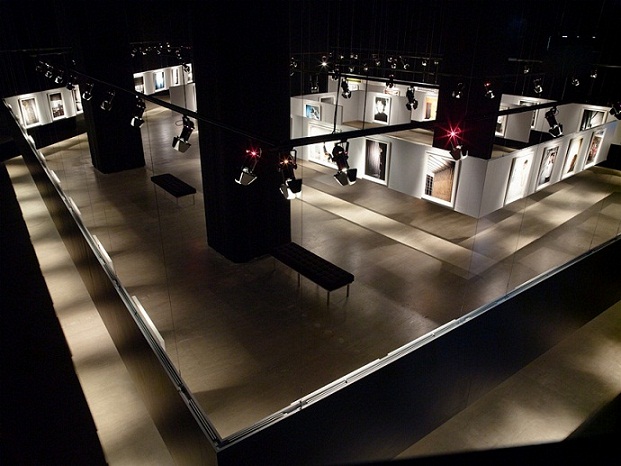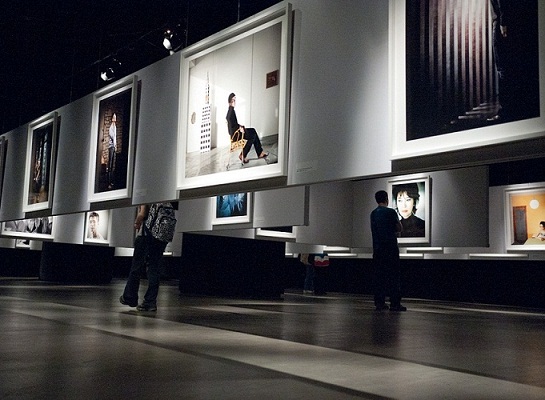Reviews & Articles
Hong Kong’s Grey-walled Art Spaces
John BATTEN
at 12:37pm on 16th July 2011


Captions:
1. & 2. Two interior views of " PROXEMICS - Photographs by Virgile Simon Bertrand " at ArtisTree, 2009. (Photos courtesy of Virgile Simon Bertrand)
3. Interior of "Memories of King Kowloon" exhibition at ArtisTree, 2011. (Photo: John Batten)
(原文以英文發表,對比太古坊 ArtisTree與香港其他藝術場地的展覽,評論香港藝術空間的發展情況。)
Teaming up with London’s venerable Victoria & Albert Museum to present an exhibition of legendary fashion designer Vivienne Westwood was a fortuitous opportunity for the newly opened ArtisTree in 2008. As a large, independent events venue to complement Swire Properties’ commercial, retail and residential portfolio in TaiKoo Place, the hosting of the prestigious Westwood exhibition was gladly accepted after being rejected by local Leisure & Cultural Services Department museums.
The 20,000 square foot ArtisTree has attracted 250,000 visitors and hosted a range of events, seminars, concerts and exhibitions since opening. Except for 10% of commercial functions held at ArtisTree that are charged for, Swire Properties selects a diverse range of cultural events to personally support or sponsor.
ArtisTree’s simple design and determination to contribute to the local Tai Koo and larger Hong Kong community is at the heart of its success. Originally a two-level industrial space, an entire floor was removed to give a 6.7 metre ceiling height with concrete walls and flooring allowing each event to be flexibly designed. In contrast, the Leisure & Cultural Services Department “multi-purpose” exhibition rooms in municipal buildings prolifically scattered around Hong Kong are of mundane design with characteristic low ceilings, linoleum floors and grey-carpeted partitioning. These overly ‘clean’ venues are inevitably inflexible, tending to host standard exhibitions and simple seminar-style events.
Hong Kong does not lack arts and community venues, but appropriate, flexible, usable and open spaces are in very short supply due to a government arts administration that retains control of most facilities. A revolution in programming, quality and variety of events would inevitably emerge if these facilities were returned to independent community groups and operators.
Equally disappointing are the proposed facilities to be included in soon to be revamped heritage buildings such as the Married Police Quarters and Central Market that will each provide nominal arts and exhibition facilities. Their design, however, follows the existing government models. These buildings should be simply designed with flexible project art spaces of concrete floors and wooden walls – backed by an open-minded management happy to contribute to and participate in our greater community.
A version of this article was originally published in the South China Morning Post on 3 July 2011.
1. & 2. Two interior views of " PROXEMICS - Photographs by Virgile Simon Bertrand " at ArtisTree, 2009. (Photos courtesy of Virgile Simon Bertrand)
3. Interior of "Memories of King Kowloon" exhibition at ArtisTree, 2011. (Photo: John Batten)
(原文以英文發表,對比太古坊 ArtisTree與香港其他藝術場地的展覽,評論香港藝術空間的發展情況。)
Teaming up with London’s venerable Victoria & Albert Museum to present an exhibition of legendary fashion designer Vivienne Westwood was a fortuitous opportunity for the newly opened ArtisTree in 2008. As a large, independent events venue to complement Swire Properties’ commercial, retail and residential portfolio in TaiKoo Place, the hosting of the prestigious Westwood exhibition was gladly accepted after being rejected by local Leisure & Cultural Services Department museums.
The 20,000 square foot ArtisTree has attracted 250,000 visitors and hosted a range of events, seminars, concerts and exhibitions since opening. Except for 10% of commercial functions held at ArtisTree that are charged for, Swire Properties selects a diverse range of cultural events to personally support or sponsor.
ArtisTree’s simple design and determination to contribute to the local Tai Koo and larger Hong Kong community is at the heart of its success. Originally a two-level industrial space, an entire floor was removed to give a 6.7 metre ceiling height with concrete walls and flooring allowing each event to be flexibly designed. In contrast, the Leisure & Cultural Services Department “multi-purpose” exhibition rooms in municipal buildings prolifically scattered around Hong Kong are of mundane design with characteristic low ceilings, linoleum floors and grey-carpeted partitioning. These overly ‘clean’ venues are inevitably inflexible, tending to host standard exhibitions and simple seminar-style events.
Hong Kong does not lack arts and community venues, but appropriate, flexible, usable and open spaces are in very short supply due to a government arts administration that retains control of most facilities. A revolution in programming, quality and variety of events would inevitably emerge if these facilities were returned to independent community groups and operators.
Equally disappointing are the proposed facilities to be included in soon to be revamped heritage buildings such as the Married Police Quarters and Central Market that will each provide nominal arts and exhibition facilities. Their design, however, follows the existing government models. These buildings should be simply designed with flexible project art spaces of concrete floors and wooden walls – backed by an open-minded management happy to contribute to and participate in our greater community.
A version of this article was originally published in the South China Morning Post on 3 July 2011.
